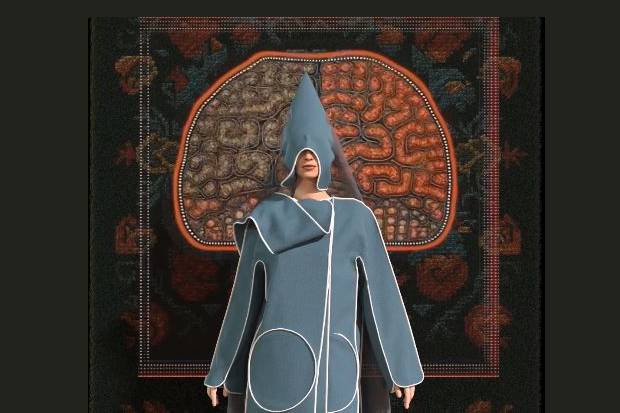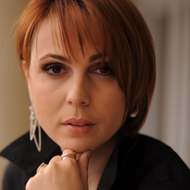HSE University and Adyghe State University Launch Digital Ethnolook International Contest

The HSE Centre for Language and Brain and the Laboratory of Experimental Linguistics at Adyghe State University (ASU) have launched the first Digital Ethnolook International Contest in the Brain Art / ScienceArt / EtnoArt format. Submissions are accepted until May 25, 2024.
Contest participants are encouraged to explore the concept of the ethnocultural code through artistic expression, drawing upon insights from cognitive science, linguistics, and neuroscience.
The aim of the contest is to create an artistic representation (for clothing, accessories, or prints) that communicates the cognitive dimension through visual elements (such as images of the brain, neural networks, etc.), showcasing the aesthetic potential of neuroscience, neurobiology, and neurolinguistics.
'The brain of a native speaker of a language, especially one fluent in multiple languages, can serve as a wellspring of inspiration. The worldview of individuals from a specific linguistic and cultural community reflects a distinct mentality that can be expressed through imagery, symbols, and colour,' comments Professor Olga Dragoy, Director of the HSE Centre for Language and Brain.
The contest is held in the framework of the Ethnomoda International Contest, whose permanent chairman is Alexander Khilkevich, trend analyst, co-founder of the National Academy of Fashion Industry, and founder of the Best Russian Designers Ranking.

Susanna Makerova
'This time, the aesthetics of neurobiology, the unique worldview of individuals from specific linguistic and cultural backgrounds, as well as culturally significant language expressions including phrases, sayings, and proverbs with an ethnocultural component, can serve as sources of inspiration for contest participants,' says the author of the project Professor Susanna Makerova, head of the ASU Laboratory of Experimental Linguistics.
The contest comprises three nominations:
3D Model—a digital portrayal of an avatar within an environment (static renders or a video clip of up to a minute)
Ornamentation (digital sketches or AI generated designs)
Accessories (sketches or 3D visualisations)
Prizes for winners include: an online course from the 3D Couture school, participation in EtnomodaArtCommunity multimedia exhibitions in Russia and CIS countries, publication of the top creations in the Digital Shkaf Telegram channel and Ethnomoda Project's social media.
To participate, please send an email to artroom.suziem@gmail.com with an application stating the author's name, creative director, and a link to social networks (if applicable), along with details such as place of study or work, city, and country. Please submit each entry in a separate email.
Requirements for submitted works: images in JPEG or PNG format, videos in MP4 format, and the file names must include the first and last name of the author.
The submission deadline is May 25, 2024.
The contest is conducted with support from the HSE Centre for Language and Brain, the ASU Laboratory of Experimental Linguistics, the Ministry of Culture of the Republic of Adyghe, Adyghe State University, the Academy of Architecture and Arts at Southern Federal University, the State Museum of Applied Arts and the History of Handicrafts of Uzbekistan, the All-Russian Museum of Decorative Arts, the Mikhail Shemyakin Centre, 3D Couture, U magazine, FashionTechPermCommunity, and EtnomodaArtCommunity.
See also:
HSE Researchers Discover Simple and Reliable Way to Understand How People Perceive Taste
A team of scientists from the HSE Centre for Cognition & Decision Making has studied how food flavours affect brain activity, facial muscles, and emotions. Using near-infrared spectroscopy (fNIRS), they demonstrated that pleasant food activates brain areas associated with positive emotions, while neutral food stimulates regions linked to negative emotions and avoidance. This approach offers a simpler way to predict the market success of products and study eating disorders. The study was published in the journal Food Quality and Preference.
HSE Neurolinguists Create Russian Adaptation of Classic Verbal Memory Test
Researchers at the HSE Centre for Language and Brain and Psychiatric Hospital No. 1 Named after N.A. Alexeev have developed a Russian-language adaptation of the Rey Auditory Verbal Learning Test. This classic neuropsychological test evaluates various aspects of auditory verbal memory in adults and is widely used in both clinical diagnostics and research. The study findings have been published in The Clinical Neuropsychologist.
Researchers at HSE Centre for Language and Brain Reveal Key Factors Determining Language Recovery in Patients After Brain Tumour Resection
Alina Minnigulova and Maria Khudyakova at the HSE Centre for Language and Brain have presented the latest research findings on the linguistic and neural mechanisms of language impairments and their progression in patients following neurosurgery. The scientists shared insights gained from over five years of research on the dynamics of language impairment and recovery.
Neuroscientists Reveal Anna Karenina Principle in Brain's Response to Persuasion
A team of researchers at HSE University investigated the neural mechanisms involved in how the brain processes persuasive messages. Using functional MRI, the researchers recorded how the participants' brains reacted to expert arguments about the harmful health effects of sugar consumption. The findings revealed that all unpersuaded individuals' brains responded to the messages in a similar manner, whereas each persuaded individual produced a unique neural response. This suggests that successful persuasive messages influence opinions in a highly individual manner, appearing to find a unique key to each person's brain. The study findings have been published in PNAS.
Arkhangelskoye Estate Museum Launches Open Call for Artists
The Arkhangelskoye Estate Museum is launching an open-call for the exhibition ‘Water in Art. Water in the Estate.’ The exhibition will feature paintings, graphics, sculptures, decorative and applied arts from the museum's collection, as well as works by young artists created specifically for the project.
'We Are Creating the Medicine of the Future'
Dr Gerwin Schalk is a professor at Fudan University in Shanghai and a partner of the HSE Centre for Language and Brain within the framework of the strategic project 'Human Brain Resilience.' Dr Schalk is known as the creator of BCI2000, a non-commercial general-purpose brain-computer interface system. In this interview, he discusses modern neural interfaces, methods for post-stroke rehabilitation, a novel approach to neurosurgery, and shares his vision for the future of neurotechnology.
Smoking Habit Affects Response to False Feedback
A team of scientists at HSE University, in collaboration with the Institute of Higher Nervous Activity and Neurophysiology of the Russian Academy of Sciences, studied how people respond to deception when under stress and cognitive load. The study revealed that smoking habits interfere with performance on cognitive tasks involving memory and attention and impairs a person’s ability to detect deception. The study findings have been published in Frontiers in Neuroscience.
'Neurotechnologies Are Already Helping Individuals with Language Disorders'
On November 4-6, as part of Inventing the Future International Symposium hosted by the National Centre RUSSIA, the HSE Centre for Language and Brain facilitated a discussion titled 'Evolution of the Brain: How Does the World Change Us?' Researchers from the country's leading universities, along with health professionals and neuroscience popularisers, discussed specific aspects of human brain function.
‘Scientists Work to Make This World a Better Place’
Federico Gallo is a Research Fellow at the Centre for Cognition and Decision Making of the HSE Institute for Cognitive Research. In 2023, he won the Award for Special Achievements in Career and Public Life Among Foreign Alumni of HSE University. In this interview, Federico discusses how he entered science and why he chose to stay, and shares a secret to effective protection against cognitive decline in old age.
'Science Is Akin to Creativity, as It Requires Constantly Generating Ideas'
Olga Buivolova investigates post-stroke language impairments and aims to ensure that scientific breakthroughs reach those who need them. In this interview with the HSE Young Scientists project, she spoke about the unique Russian Aphasia Test and helping people with aphasia, and about her place of power in Skhodnensky district.



